If you want to keep any of the common North American toads as pets, keep in mind that they hide most of the time.
Toadfrogs” were what I and other neighborhood kids in east-central New Jersey first called them as a child. American (Anaxyrus americanus) and Fowler’s (A. fowleri) toads (both formerly in the genus Bufo) were common in the glow beneath street lights as they gathered there to zero in on the many bugs that would accumulate during warm summer nights. Some nights I stood guard over them for hours, moving the toads away to nearby yards so they wouldn’t get squashed by cars. I chuckle at that now, realizing that although I was saving them (if only temporarily), I was also depriving them of some easy meals.
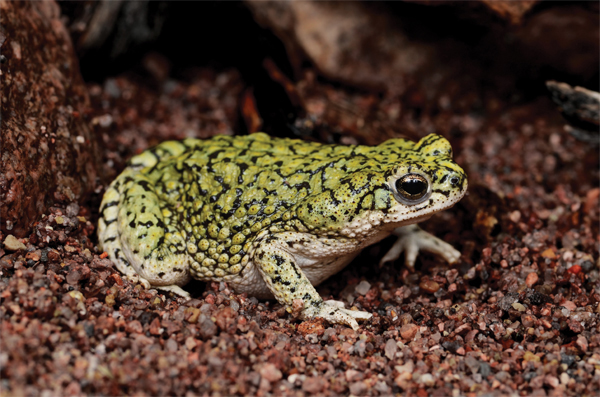
bill love
Green toads, such as Anaxyrus debilis, occupy some of the harshest desert environment in the country.
Toads were welcomed by everyone on my street as gentle garden inhabitants. “They’re good because they eat the bad bugs that eat our vegetables,” my mother told me. No one minded a few living on their property, and some people even encouraged toads to set up residence by placing flat pavers within gardens, with a rock beneath one corner to elevate it and create a crawlspace for toads to shelter beneath. Locating one of these hides near a dripping spigot made for an exceptionally favorable wild toad shelter.
Later, as friends and I started exploring nearby ponds and marshes, we encountered the true water-loving anurans—leopard and pickerel frogs, and bullfrogs. These were species that could leap great distances to elude our hands and nets. As these slippery cousins to the toads became familiar, we adjusted our nomenclature and began referring to the the land-based, slow-hopping creatures found in our neighborhoods to “hop toads.” This seemed appropriate, and more accurate.
All toads are frogs, but not all frogs are toads. The term “toad” generally represents those anurans broadly defined as the high-and-dry counterparts of more water-bound frogs. There can be exceptions, usually stemming from an animals’ common name. For instance, the popular Asian fire-bellied “toads” of the genus Bombina are actually frogs with slightly bumpy skin. The moniker with “toad” simply stuck as part of their name in the pet trade. For the most part, however, toads are usually the frogs that, after emerging from their watery birthplaces, spend most of their adult lives on land. They have drier, warty skin, and they can live far from permanent water sources.
I think toads make better pets than frogs. They are less “boingy” and nervous, they don’t bash their snouts against terrarium walls as much, and they are easier to hold (even if they do tend to pee when first handled, especially when first picked up). The old wives’ tale about toads passing warts on to people is a silly myth.
Pet Toad Tips
If you want to keep any of the common North American toads as pets, keep in mind that they hide most of the time. To enjoy them, you must either dig them out from their hidey holes, or patiently wait to observe them when they’re active at night. When they emerge after sunset, though, pet toads can be counted on to enthusiastically chase down any small insects and worms you have released into their enclosure. If given the opportunity, they will feed every night.
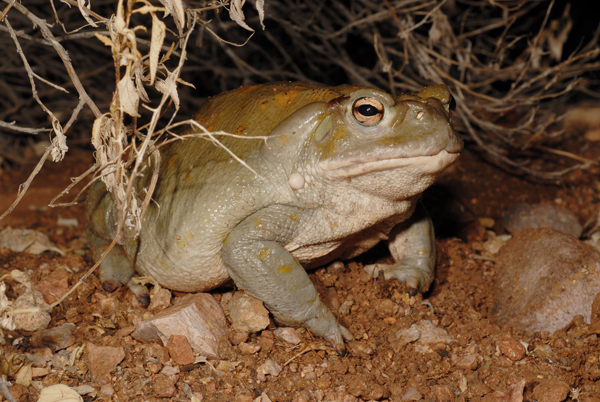
bill love
With a potential length of 8 inches, the Sonoran desert toad (Incilius alvarius) is the largest native toad in the U.S.
With the ready availability of feeder insects today, providing captive toads plenty of food is not the problem it was for me during my childhood back in the mid-1960s. I quickly learned that toads were more adept at feeding themselves than I was at collecting bugs daily, so I soon moved on to keeping turtles and snakes. Of course, I sometimes relied on my old toad pals as a source of food for larger garter and water snakes—they were easier to catch, and my snakes seemed to relish them as much as they did frogs.
Besides supplying pet toads with a variety of food bugs, the other trick to maintaining them over the long term is to be sure to change their several inches of soil or mulch cage substrate regularly, at least every couple of weeks. In nature, toads move constantly and aren’t forced to sit in soiled bedding. Moisture and toxins are readily absorbed through the skin of a toad’s belly and legs, and in a cage, bacteria in the substrate can build up rapidly due to feces and uneaten bugs. This can contaminate the soil, resulting in skin infections.
A shallow water dish needs to be available, filled halfway with clean water to avoid excessive overflow when your toad plops down in it to soak. Leave it in the cage overnight. It will be completely filthy by morning due to the toad hopping in and out of it. Wash and sterilize the water dish afterward, let it dry between uses, and reintroduce it every few days.
Toads and frogs are facing a rough future due to human encroachment on their environments. Wetlands are drained for development and to reduce breeding grounds for mosquitoes. This reduces suitable breeding sites for all amphibians while also introducing new dangers, such as road traffic, domestic pets that occasionally prey on them, and pollution to whatever natural habitat remains. For these reasons, you would be better off acquiring a captive-bred toad that is bigger and more “hands-on”—and therein lies a problem.
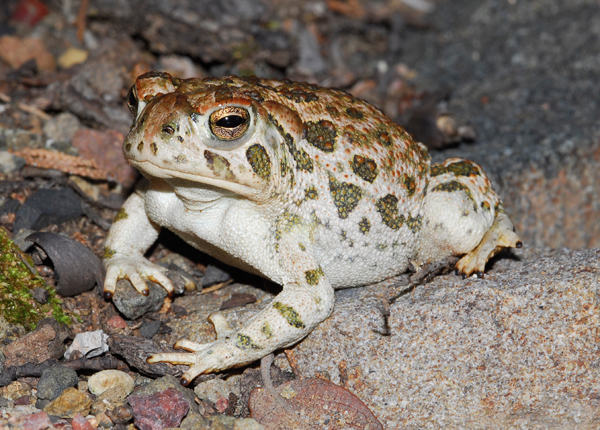
bill love
Dry desert grasslands of the U.S. are home to the Great Plains toad (Anaxyrus cognatus).
No one is breeding any true toads on a large scale for the pet trade. Interestingly, almost all the herpetocultural efforts of the past four decades have concentrated on frogs. This strikes me as odd due to the wide assortment of toad species existing in the world. Most can’t match frogs in regard to having an exciting, colorful appearance, which may be part of the answer, but for handling, there isn’t a toad more impressive in my mind than the huge Blomberg’s toad (Bufo [Rhaebo] blombergi) from southwestern Colombia. Unfortunately, it hasn’t been available widely for many decades.
Common U.S. Toads
Collectively, the range of our native toads covers the entire U.S. Following are some notes regarding some of the types living across the country.
American toad (Anaxyrus [formerly Bufo] americanus). A familiar creature in the northeastern U.S., this is the quintessential toad for many North Americans due to its abundance where our populations are the greatest. Anyone who spends a modicum of time tending their garden is familiar with this toad, and probably welcomes its predations on a variety of insects that might threaten veggie crops. At up to 3½ inches in body length, it has an impressive appetite and can consume many dozens, even hundreds, of bugs per night.
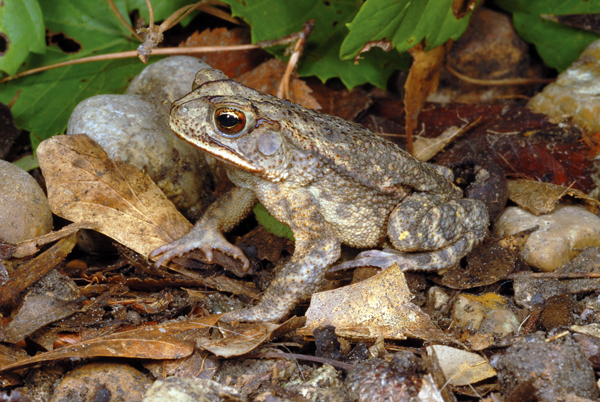
bill love
The Gulf Coast toad (Incilius valliceps) is common in southern Louisiana and southeast Texas.
American toads prefer to burrow into loose soil by day, or shelter beneath stones, boards or whatever might be lying around on the ground retaining moisture. The wetter the recent weather, the closer to the surface toads will remain hidden until nightfall, when they emerge to forage. This and most other toads are nocturnal hunters, although warm, cloudy days may also entice them out.
The American toad’s life cycle mirrors what’s normal for many other types of toads. Mature toads seek standing bodies of water for breeding during the hot months of the year. Males usually arrive at breeding sites first and claim territories along the shallow edges of water to trill. Trills are mating calls—extended monotone warbles that last anywhere from five to 30 seconds at a time. They are used to attract females by advertising that the males are present in suitable places and ready to reproduce.
When receptive females approach, eager males hop onto their backs and embrace them firmly in a bear hug known as amplexus, letting the females know it’s time to expel eggs. American toads push out two strings of clear jelly with individual dark eggs inside spaced approximately every quarter of an inch. Males fertilize them externally by squirting sperm on them as they pass. A typical deposit can contain up to twenty thousand eggs. Huge numbers are needed to assure that a few dozen will survive to adulthood over the following two to three years.
After a week or two, hundreds of tadpoles (I knew them as “pollywogs’” growing up in New Jersey) break through the deteriorating gel strings and enter their next stage of life as free-swimmers. They steadily develop for two months, eating algae and sprouting arms and legs while the long, thin tadpole tail is slowly absorbed. All this time, they must avoid being eaten by a host of other pond life eager to snack on them—fish, large aquatic insects, turtles and wading birds are their most significant predators. The toxic skin secretions that make adult toads distasteful to some of their predators is not present to any degree in tadpoles to assist them in their struggles to reach adulthood.
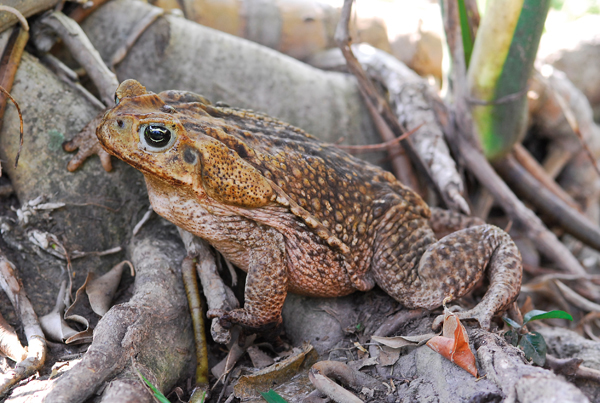
bill love
The giant, or marine, toad (Rhinella marina) became a famously invasive species in Australia, where it is known as the cane toad.
The tail is completely gone by the time the toadlets leave the water as little, half-inch miniature versions of the adults. Now their diet switches to small bugs as they stay near moist ground with plenty of cover foliage. A new variety of dangers lurk on land, notably water and garter snakes, bullfrogs, birds and rodents. Fowler’s toad (A. fowleri). This toad looks a lot like the American toad, but can be easily distinguished by its (typically) grayer coloration and reddish spots (American toads are usually a warmer brown or reddish, but are sometimes gray, too), and its cranial crests, which are raised, angular ridges behind the eyes on the back of the head that touch the puffy parotid (toxin-exuding) glands. The cranial crests and parotid glands on American toads are slightly separated. Fowler’s toads also have at least three, small, lighter-colored warts inside each larger spot on their backs.
Fowler’s toads prefer more open, sandy habitat than A. americanus, and they breed slightly later in the year. Their call is much shorter, a one or two-second buzzy trill that sounds like a sheep bleating. During the frenzy of breeding a male may accidentally grab another male in amplexus, and when this occurs, a special release call is utilized.
Woodhouse toad (A. woodhousii). Another “typical toad” that grows slightly larger—up to 5 inches—than most of the species that border its range. This is the common toad of the midwestern U.S.
Gulf Coast toad (Incilius valliceps). This is the most conspicuous toad of southern Louisiana and southeastern Texas. Some authorities are now lumping U.S. examples with other species, with I. valliceps as a separate species south of the U.S. border.
Great Plains toad (A. cognatus). The Great Plains toad is a rotund species that inhabits dry desert grasslands. It reaches 4 to 5 inches and is boldly marked with large ovals of dark pigment dorsally.
Western toad (A. boreas). The common toad of the western U.S., from Mexico to Canada. This species is prone to chirp loudly when picked up.
Red-spotted toad (A. punctatus). A smaller type of desert toad characterized by varying numbers of raised red “pimples.” They arrive in force on the surface scene after summer rains make conditions favorable.
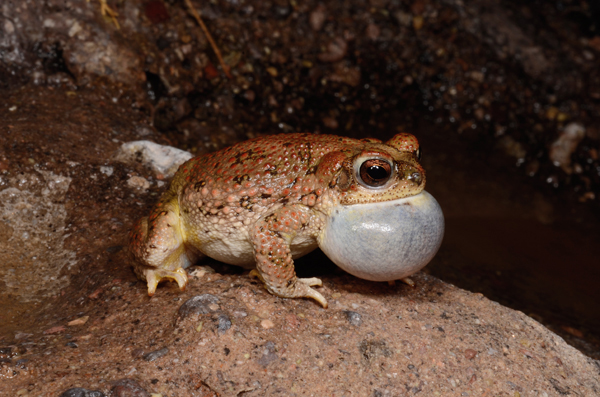
bill love
A male red-spotted toad (Anaxyrus punctatus) tries to attract a female by calling.
Green toads (A. debilis and A. retiformis). These slender toads eke out their existence in some of the harshest desert flats where vegetation is sparse. They seek temporary water immediately after summer monsoons soak their otherwise parched homelands.
Spadefoot toads (genera Scaphiopus and Spea). The western U.S. is an especially unfriendly place for amphibians, but several species of spadefoots have conquered the problem of dehydration in that often-dry climate. By being active above ground for only relatively brief periods, they’ve solved the water dilemma admirably. The majority of their time is spent burrowed in the soil, a feat aided immensely by a hard projection on the bottom of the rear feet that acts like a shovel or spade. Spadefoot toads only come to the surface after rains loosen the soil and bring insects out in numbers for the toads to feed upon. Summer rains are also what beckons them to fresh puddles to procreate.
Spadefoots of all kinds seek only temporary sources of standing water for a very good reason: they lack water-dwelling competitors such as fish that would gobble down the spadefoots’ tadpoles. The toads gather in huge aggregations of explosive gatherings for breeding, often dominating a water hole for the first night of intense rain. Their strategy is simple: Be the first at the new “pond” and lay massive amounts of eggs that will hatch within a couple days and develop like there’s no tomorrow. If your life depends on metamorphosing before your pond dries up, rapid development is a big plus.
Oak toad (A. quercicus). This small toad averages about 1 inch in total length, and specimens are often mistaken for juveniles of the more common 2 to 3-inch toad species that share their pine woods environments in the southeastern U.S. A distinct white or cream line runs down the midline of their backs to help differentiate them. They are primarily gray with black spots or blotches.
Oak toads prey on small arthropods such as termites, and often do so by daylight in the open grassy patches within the forest. They utilize rain puddles to breed, and are particularly fond of ditches and swales bordering roadways in low-lying areas. Lesser numbers of eggs are laid in short gelatinous strings. The oak toad’s vocal pouch resembles an elongate balloon that extends out in front of its mouth when it calls while clinging to plant matter in shallow water. The call, especially from multiple individuals at once, sounds exactly like a bunch of baby chicks cheeping.
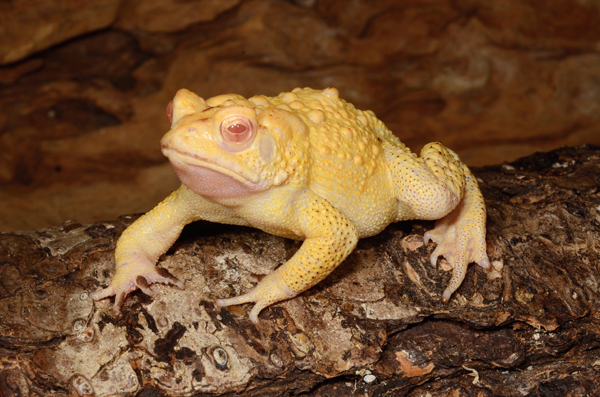
bill love
The well-known American toad (Anaxyrus americanus; this is an amelanistic specimen) is favored by many homeowners for its garden pest control capabilities.
Sonoran Desert toad (I. alvarius). Our largest native toad was known in bygone times as the Colorado River toad. It’s predominantly dull green in color, and it’s rather smooth-skinned for a toad. Adults are easily identified by the noticeable white wart where the jaw lines meet, and also the large, flat warts on the hind legs. This bruiser of a toad reaches 8 inches in length and sometimes up to 2 pounds in weight! It eludes capture by running away surprisingly fast on all four legs.
As its name implies, it lives in the Sonoran Desert, mostly in Arizona. Like other toad species inhabiting arid habitats, it goes underground to survive the fierce heat of day. It is a strictly nocturnal toad and not active every night. Rain is the key to bringing it out en masse, and that’s mostly a July/August/September phenomenon within its range. On those special nights, puddles and the glow under streetlights attract Sonoran Desert toads by the dozens.
Like many other types of toads, I. alvarius has huge parotid glands that can ooze a light sticky liquid to discourage predators. No human has ever died from it, but many have become sick by accidentally ingesting the toxins after careless handling. Hallucinations may occur after absorbing it, leading to occasional illegal harvest and use of the toxins for recreation. Native North American cultures have for centuries been known to trade Sonoran Desert toads widely down through Central America for this purpose.
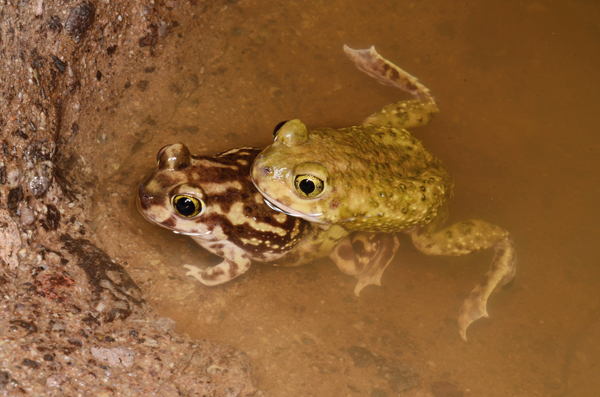
bill love
A pair of Couch’s spadefoot toads (Scaphiophus couchii) engaged in amplexus.
Giant toad (Rhinella marina [formerly Bufo marinus]). Also known as the marine toad, this South American native grows to about 10 inches nose to butt and is among the largest of all toads. Its appearance follows the usual toad formula for looks: shades of browns, tans, and black with a spotty, bumpy skin. It has huge parotid glands behind the eyes that exude a viscous, toxic goo if a toad is handled too roughly or attacked by a potential predator.
Dogs unfortunately learn this the hard way when they playfully mouth them. I can personally attest to their deadly nature when I witnessed a friend’s dog, which had accompanied us looking for marine toads one night in southern Florida. The dog carried a large specimen around for a minute or so, then spit it out. Within minutes, the dog was coughing convulsively, and it struggled to breathe for the next 15 minutes as we tried to wash its mouth out with a garden hose. The effort was in vain, and the poor dog succumbed later that evening.
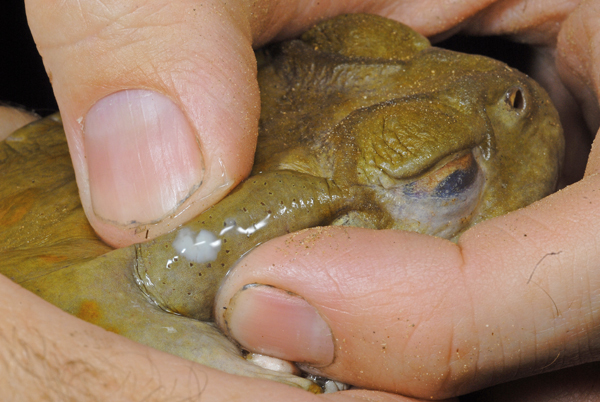
bill love
The toxin secreted by the large parotid glands of a Sonoran Desert toad is sometimes used as a hallucinogen.
Perhaps the best-known toad to the general public worldwide, this large toad owes its fame to its success at being an invasive species in several areas around the planet. Notably, this warty mini-behemoth has become established in Australia, where it is known as the cane toad because it was imported and released to supposedly control agricultural pests in sugar cane plantations in northeastern Australia during the mid-1960s. The toad has proliferated since then.
During the dark ages the toxic secretions of toads led to accusations of their utilization in witches’ brews, and due to their “ugly,” warty skin (compared to humans, anyway), it is often advised to avoid making contact with them. It would be sheer ignorance to continue believing these concerns of yesteryear. If you know anyone who still harbors these outdated beliefs, please do the planet a favor and educate them to the reality science has revealed to us: that toads deserve our admiration and respect.
Bill Love photographs herps in nature, writes and lectures. He assists his wife, Kathy, with her business, CornUtopia, and via his company, Blue Chameleon Ventures, leads nature tours to view herps in Madagascar.


